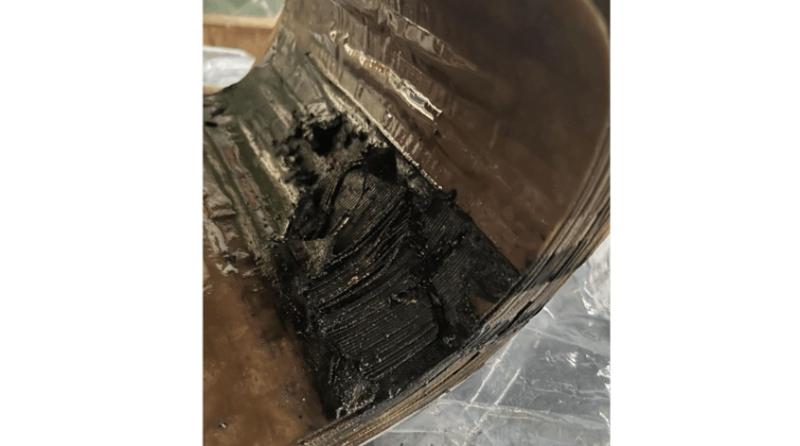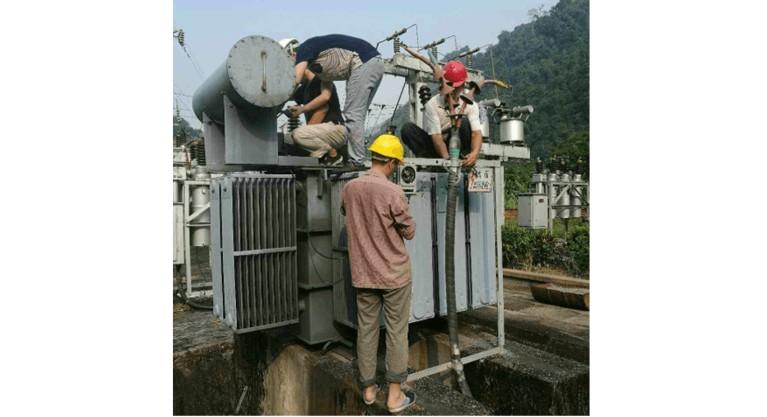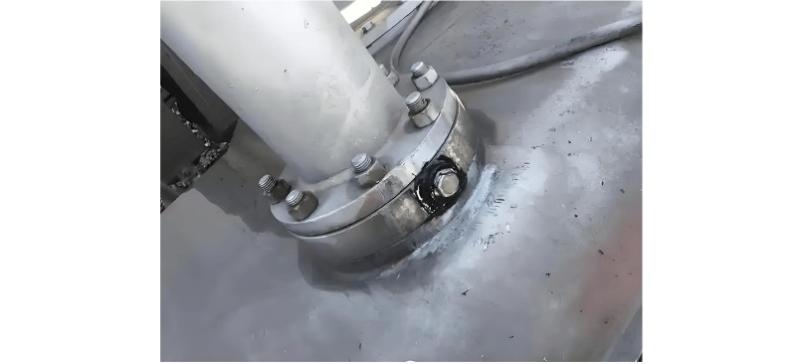변압기의 일반적인 고장 및 처리 방법.
1. 변압기 과열
과열은 변압기에 매우 해롭습니다. 대부분의 변압기 절연 고장은 과열로 인해 발생합니다. 온도가 상승하면 절연 재료의 유전 강도와 기계적 강도가 감소합니다. IEC 354, 변압기 적재 가이드는 변압기의 가장 뜨거운 부분의 온도가 140°C에 도달할 때 오일 내에서 거품이 형성된다고 명시하고 있습니다. 이러한 거품은 절연 성능을 저하시키거나 번개 전류를 유발하여 변압기를 손상시킬 수 있습니다.
과열은 변압기의 수명에 큰 영향을 미칩니다. 변압기 6°C 규칙에 따르면 80-140°C 범위에서 온도가 6°C 증가할 때마다 변압기 절연 효과 수명 감소율이 두 배로 늘어납니다. 국가 표준 GB1094는 유침식 변압기의 평균 와인딩 온도 상승 제한을 65K, 상부 오일 온도 상승을 55K, 코어와 탱크를 80K로 규정하고 있습니다.
변압기 과열은 주로 오일 온도의 비정상적인 상승으로 나타납니다. 가능한 주요 원인은 다음과 같습니다: (1) 변압기 과부하; (2) 냉각 시스템 고장 (또는 냉각 시스템의 불완전한 작동); (3) 변압기 내부 고장; (4) 온도 측정 장치의 잘못된 표시.
변압기 오일 온도의 비정상적인 상승이 발견되면 위의 가능한 원인을 하나씩 점검하여 정확한 판단을 내려야 합니다. 주요 점검 및 처리 사항은 다음과 같습니다:
(1) 운영 중인 계측기들이 변압기가 과부하 상태임을 나타내고, 단상 변압기 뱅크의 세 개의 위상 온도계가 기본적으로 일관된 읽수 (몇 도의 편차 가능)를 보여주며, 변압기와 냉각 시스템이 정상적으로 작동 중이라면, 온도 상승은 과부하로 인한 것일 가능성이 높습니다. 이 경우 변압기 (부하, 온도, 작동 상태)에 대한 모니터링을 강화하고 즉시 상위 조정 부서에 보고하며, 부하를 전환하여 과부하의 크기와 지속 시간을 줄이는 것을 권장합니다.
(2) 냉각 시스템의 불완전한 작동으로 인한 온도 상승이라면 시스템을 즉시 활성화해야 합니다. 냉각 시스템이 고장났다면 원인을 신속히 파악하고 즉시 해결해야 합니다. 만약 고장이 신속히 해결되지 않는다면 변압기의 온도와 부하를 면밀히 모니터링하고 계속해서 조정 부서와 생산 관리 부서에 보고해야 하며, 변압기 부하를 줄이고 현재 냉각 조건에 맞는 냉각 용량에 해당하는 부하 값에 따라 변압기를 작동시켜야 합니다.
(3) 원격 온도 측정 장치가 매우 높은 값을 표시하며 고온 경보 신호를 발송하지만 현지 온도계는 정상적인 읽수를 보이고 다른 변압기 고장 징후가 없다면, 경보는 원격 온도 측정 회로의 고장으로 인한 거짓 신호일 수 있습니다. 이러한 고장은 적절한 시기에 수정할 수 있습니다.
(4) 삼상 변압기 뱅크에서 한 위상의 오일 온도가 동일한 부하와 냉각 조건에서도 역사적인 오일 온도보다 크게 상승하고, 냉각 시스템과 온도계가 정상적이면, 과열은 변압기 내부 고장으로 인한 것일 수 있습니다. 즉시 전문가에게 통보하여 샘플 오일을 채취하여 크로마토그래피 분석을 수행하여 고장을 더 정확히 식별해야 합니다. 크로마토그래피 분석이 내부 고장을 나타내거나 부하와 냉각 조건이 변경되지 않았음에도 불구하고 오일 온도가 계속 상승한다면, 현장 규정에 따라 변압기를 운용에서 제외해야 합니다.

2. 냉각 시스템 고장
냉각 시스템은 변압기 오일을 통해 와인딩과 코어로부터 열을 방출하는 역할을 합니다. 500kV 주 변압기는 모두 강제 유순환 강제 공기 냉각을 사용합니다. 냉각 시스템이 정상적으로 작동하는지 여부는 변압기의 정상적인 운용에 중요한 조건입니다. 냉각 장비 고장은 일반적인 변압기 고장입니다. 냉각 장비가 고장나면 변압기의 운용 온도가 급격히 상승하고 절연 수명 손실이 급격히 증가합니다.
냉각 장비 고장 시 운영자는 변압기의 온도와 부하를 면밀히 모니터링하고 지속적으로 조정 부서와 운영 관리자에게 보고해야 합니다. 만약 고장난 냉각 조건에서 변압기 부하가 지정된 제한을 초과한다면, 현장 규정에 따라 부하 감소를 요청해야 합니다.
유온 상승 시 코어와 와인딩이 오일보다 빠르게 가열됩니다. 오일 온도는 약간만 상승했더라도 코어와 와인딩 온도는 이미 매우 높을 수 있습니다. 특히 오일 펌프가 고장났을 때, 와인딩의 온도 상승은 명판에 지정된 정상값을 크게 초과할 수 있습니다. 오일 온도는 약간 또는 눈에 띄지 않게 상승했을 수도 있지만, 코어와 와인딩 온도는 이미 허용 한도를 크게 초과할 수 있습니다.
나중에 오일 온도가 점차 상승하면서 코어와 와인딩 온도는 더욱 높아지고, 주어진 부하와 냉각 조건에서 오일 대비 특정 온도 상승을 유지합니다. 따라서 냉각 장비 고장 시에는 오일 및 와인딩 온도뿐만 아니라 제조사와 현장 규정에 따른 냉각 시스템 중단 시 변압기의 허용 운용 용량과 시간을 준수해야 합니다. 다른 운용 변화도 모니터링하여 변압기의 운용 상태를 종합적으로 평가해야 합니다.
냉각 장비 고장을 점검하기 위해 고장 범위를 확인해야 합니다 (개별 팬이나 오일 펌프 중단, 전체 그룹 중단, 단상 또는 삼상 중단), 냉각 시스템 제어 회로도를 참조하여 고장 지점을 찾아 냉각 장비의 중단 시간을 최소화해야 합니다.
개별 팬이나 오일 펌프가 고장났지만 다른 것이 정상적으로 작동할 경우 가능한 원인은 다음과 같습니다:
팬이나 오일 펌프에 공급되는 삼상 전원 중 하나의 선이 단락되었거나 (퓨즈가 녹았거나 접촉이 나쁘거나 선이 끊겼음), 모터 전류가 증가하여 열릴레이 작동 또는 전원 차단, 또는 모터 소모;
팬이나 오일 펌프의 베어링이나 기계적 고장;
팬이나 오일 펌프 제어 회로의 해당 제어 릴레이, 컨택터, 기타 구성 요소의 고장 또는 회로 단락 (예: 느슨한 단자, 접촉 불량);
열릴레이 설정 값이 너무 낮아 거짓 작동.
원인이 전원 또는 회로 고장인 경우 단선을 신속히 복구하고 퓨즈를 교체하여 전원과 회로를 복구해야 합니다. 제어 릴레이가 손상되었다면 예비품으로 교체해야 합니다. 팬이나 오일 펌프가 손상되었다면 즉시 유지보수를 요청해야 합니다.
그룹 (또는 여러) 팬이나 오일 펌프가 동시에 중단되면, 그룹에 대한 전원 고장, 퓨즈 녹아내림, 열릴레이 작동, 또는 손상된 제어 릴레이가 원인일 가능성이 높습니다. 예비 팬이나 오일 펌프를 즉시 작동시키고 고장을 복구해야 합니다.
주 변압기의 모든 팬이나 오일 펌프가 중단되면, 냉각 시스템의 1상 또는 3상의 주 전원 고장 때문일 것입니다. 이 경우 예비 전원이 자동으로 작동했는지 확인해야 합니다. 그렇지 않다면, 예비 전원을 신속히 수동으로 작동시키고 고장 원인을 파악하여 제거해야 합니다.
전원 고장 처리 및 전원 복구 시 다음 사항을 유의해야 합니다:
퓨즈를 교체할 때는 먼저 회로의 전원과 부하측 스위치 또는 격리기를 오프해야 합니다. 실시간 퓨즈 교체 중 두 번째 단자를 설치할 때, 3상 모터는 2상 전력을 받게 되어 큰 전류가 흐르게 되어 새로 설치한 퓨즈가 녹아내릴 수 있습니다.
설계에 맞는 사양과 용량의 퓨즈를 사용하세요.
전원 복구 후 냉각 장비를 다시 시작할 때는 가능한 한 단계별로 또는 그룹별로 시작하여 모든 팬과 오일 펌프가 동시에 시작되어 전류 급증으로 퓨즈가 다시 녹아내리는 것을 방지해야 합니다.
3상 전원이 복구된 후에도 팬이나 오일 펌프가 시작되지 않는다면, 열릴레이가 리셋되지 않았을 수 있습니다. 열릴레이를 리셋하세요. 냉각 장비에 고장이 없다면 정상적으로 다시 시작해야 합니다.

3. 비정상적인 오일 수위
변압기의 비정상적인 오일 수위는 주 탱크 오일 수위와 온라인 탭 체인저 (OLTC) 오일 수위를 포함합니다. 500kV 변압기는 일반적으로 다이어프램이나 블래더가 있는 오일 저장소를 사용하며, 포인터형 오일 수위계로 오일 수위를 표시합니다. 두 가지 모두 수위계를 통해 수위를 확인할 수 있습니다.
변압기 오일 수위가 낮다면 원인을 조사해야 합니다. 낮은 환경 온도나 경량 부하로 인해 오일 온도가 최소 오일 수위선까지 떨어진 경우라면, 즉시 오일을 추가해야 합니다. 심각한 오일 누출로 인해 수위가 떨어진 경우 즉시 누출을 막고 오일을 추가해야 합니다.
변압기 오일 수위가 높아질 수 있는 원인은 다음과 같습니다:
오일 수위가 너무 높을 때는 부하와 오일 온도를 확인하고, 냉각 시스템의 정상성을 확인하고, 모든 밸브 위치가 올바른지 확인하며, 내부 고장 징후를 확인해야 합니다. 오일 수위가 극도로 높거나 오일이 넘치는 경우, 다른 고장이 없는 경우 적당량의 변압기 오일을 배출할 수 있습니다.
OLTC 오일 저장소의 높은 오일 수위는 오일 온도 외에도 전기 접점의 과열이나 다른 이유로 인해 OLTC 구역의 밀봉이 실패하여 주 탱크의 절연 오일이 OLTC 구역으로 누출되어 OLTC 오일 수위가 비정상적으로 상승할 수 있습니다. OLTC 오일 수위가 비정상적으로 지속적으로 상승하여 OLTC 오일 저장소의 브레더에서 오일이 넘칠 때는 즉시 조정 부서에 보고하고 전문가에게 검사와 분석을 요청하며, 고장 변압기를 운용에서 제외하고 유지보수를 수행해야 합니다.
500kV 변압기는 일반적으로 다이어프램이나 블래더가 있는 오일 저장소와 포인터형 오일 수위계를 사용하며, 다이어프램이나 블래더의 바닥 위치에 따라 오일 수위를 표시합니다. 다음 조건은 포인터 표시가 정확하지 않을 수 있습니다:
다이어프램이나 블래더 아래에 가스가 축적되어 실제 오일 수위보다 떠있어 더 높은 오일 수위를 표시함;
브레더가 막혀 오일 수위가 떨어질 때 공기가 들어오지 않아 더 높은 오일 수위를 표시함;
블래더나 다이어프램이 파열되어 오일이 위쪽 공간으로 들어가서 더 낮은 오일 수위를 표시할 수 있음.
이 세 가지 상황은 잘못된 오일 수위 표시를 초래할 수 있으므로, 운영자는 정상적인 운용 중에 주의 깊게 관찰하고 분석해야 합니다.

4. 경량 가스 릴레이 작동
경량 가스 릴레이가 작동하면 변압기의 비정상적인 운용을 나타내므로 즉시 점검하고 처리해야 합니다. 방법은 다음과 같습니다:
(1) 변압기의 외관, 소리, 온도, 오일 수위, 부하를 점검합니다. 심각한 오일 누출이 발견되고 오일 수위가 게이지의 0 마크 아래이며, 가스 릴레이 수준의 알람 신호를 트리거하는 수준 아래로 떨어졌다면, 변압기를 즉시 운용에서 제외하고 누출을 신속히 수리해야 합니다.
비정상적인 온도 상승이나 이상한 운용 소리가 발견되면 내부 고장이 있을 수 있습니다. 변압기의 비정상 소리는 두 가지 유형이 있습니다: 기계적 진동으로 인한 것과 부분 방전으로 인한 것. 청진捧着的这部分似乎没有完整结束,但根据您的要求,我将继续翻译剩余的内容。以下是接续的部分:
변압기의 비정상 소리는 두 가지 유형이 있습니다: 기계적 진동으로 인한 것과 부분 방전으로 인한 것. 청진봉 (또는 손전등)을 사용하여 한쪽 끝을 케이싱에 단단히 누르고 다른 끝에서는 귀로 소리를 듣는 것으로 내부 구성 요소 (기계적 진동 또는 부분 방전)에서 소리가 나는지를 확인할 수 있습니다. 방전 소리는 일반적으로 고압 부시에서 코로나 노이즈와 유사한 리듬감 있는 패턴을 가집니다. 내부 방전 소리가 의심된다면 즉시 오일 크로마토그래피 분석을 수행하고 모니터링을 강화해야 합니다.
(2) 가스 샘플을 추출하여 분석합니다. 일반적으로 현장에서 질적 판단과 실험실에서 양적 분석을 결합합니다.
가스 샘플링을 위해 적절한 용량의 주사를 사용합니다. 주사기의 바늘을 제거하고 플라스틱 또는 오일 내성 고무 튜브를 연결합니다. 샘플링 전에 주사기와 튜브를 변압기 오일로 채워 공기를 제거한 후 플런저를 완전히 밀어 오일을 배출합니다. 튜브를 가스 릴레이의 배기 밸브에 연결합니다 (밀폐 연결을 확인). 가스 릴레이 배기 밸브를 열고 주사기 플런저를 천천히 당겨 가스를 주사기로 빨아들입니다.
주사기 바늘에 불꽃을 가져다 대고 플런저를 천천히 밀어 가스를 방출하면서 가스가 연소되는지 관찰합니다. 동시에 가스를 실험실로 보내 가스 구성 분석을 진행하여 정확한 판단을 내립니다.
가스가 연소되거나 크로마토그래피 분석으로 내부 고장이 확인되면 변압기를 즉시 운용에서 제외해야 합니다.
가스가 무색, 무취, 불연성이고 크로마토그래피 분석으로 공기로 판명될 경우, 가스 릴레이 알람은 2차 회로 고장으로 인한 거짓 신호일 수 있습니다. 회로를 점검하고 신속히 수리해야 합니다.
가스 샘플링 시 무색 투명한 주사기를 사용하여 가스 색상을 쉽게 관찰할 수 있도록 합니다. 절차는 엄격한 감독 하에 이루어져야 하며, 생활 전력 부품과 안전 거리를 유지해야 합니다.
5. 변압기 트리핑
변압기가 자동으로 트리핑될 경우 즉시 종합적인 점검을 수행하여 원인을 파악한 후 조치해야 합니다. 구체적인 점검 항목은 다음과 같습니다:
(1) 보호 릴레이 신호, 고장 기록기, 기타 모니터링 장치의 표시 또는 프린트 아웃을 통해 어떤 보호가 작동했는지 확인합니다.
(2) 트리핑 전 부하, 오일 수위, 오일 온도, 오일 색상, 오일 분사, 연기, 부시 방전 또는 파손, 압력 해방 밸브 작동 등의 명백한 고장 징후를 확인하고, 가스 릴레이에 가스가 있는지 확인합니다.
(3) 고장 기록기 파형을 분석합니다.
(4) 시스템 상태를 이해합니다: 보호 구역 내외에서 단락 고장이 발생했는지, 시스템 운용이나 전환 과전압, 혹은 닫힘 시 인러시 전류가 발생했는지 등을 확인합니다.
점검 결과 트리핑이 변압기 고장이 아닌 외부 고장으로 인한 것이라면, 외부 고장이 해결된 후 변압기를 재운용할 수 있습니다.
다음과 같은 조건이 발견되면 내부 변압기 고장이 의심됩니다. 원인을 파악하고 고장을 해결한 후, 전기 시험, 크로마토그래피 분석 등 대상 시험을 통해 고장이 해결되었음을 확인한 후에야 재운용해야 합니다:
(1) 가스 릴레이에서 추출한 가스가 분석 결과 연소 가능하다고 확인됨; (2) 변압기의 명백한 내부 고장 징후, 예를 들어 탱크 변형, 비정상적인 오일 수위, 심각한 오일 분사; (3) 변압기 부시에 명백한 방전 표시 또는 파손, 파열; (4) 두 개 이상의 보호 릴레이 (차동, 가스, 압력) 작동.
6. 비정상 소음
(1) 소음이 크고 시끄럽다면, 변압기 코어 문제일 가능성이 있습니다. 예를 들어, 클램프나 코어 고정 볼트가 느슨할 수 있습니다. 계측기 읽수는 일반적으로 정상이며, 오일 색상, 온도, 수위는 큰 변화가 없습니다. 이 경우 변압기 운용을 중지하고 점검해야 합니다.
(2) 소음에 끓는 물 소리나 "글글" 거품 소리가 포함되어 있다면, 심각한 와인딩 고장으로 인해 근처 부품이 과열되어 오일이 증발할 수 있습니다. 탭 체인저의 접촉 불량으로 인한 국소 과열이나 와인딩 간 단락이 이러한 소음을 발생시킬 수 있습니다. 즉시 변압기 운용을 중지하고 유지보수를 수행해야 합니다.
(3) 소음에 큰, 불규칙한 폭발 소리가 포함되어 있다면, 변압기 본체의 절연 파괴일 가능성이 있습니다. 운용을 중지하고 유지보수를 수행해야 합니다.
(4) 소음에 "찌찌" 방전 소리가 포함되어 있다면, 변압기 본체나 부시에서 표면 부분 방전일 가능성이 있습니다. 부시 문제가 있다면, 날씨가 좋지 않거나 밤에는 코로나 광이나 작은 청색/자홍색 스파크가 보일 수 있습니다. 부시 표면을 청소하고 실리콘 오일이나 실리콘 그리스를 적용합니다. 변압기를 중지하고 코어 접지와 활성 부품과 지면 사이의 간격이 요구 사항을 충족하는지 확인합니다.
(5) 소음에 지속적이고 리듬감 있는 두드리거나 비벼지는 소리가 포함되어 있다면, 특정 구성 요소의 진동으로 인한 기계적 접촉이나 정전기 방전으로 인한 비정상 소음일 가능성이 있습니다.
7. 오일 분사 및 폭발
오일 분사 및 폭발은 내부 고장으로 인한 단락 전류와 고온 전류가 변압기 오일을 급속하게 노화시키고, 보호 릴레이가 전원을 제때에 차단하지 못하여 고장이 지속되면서 내부 탱크의 압력이 계속 증가할 때 발생합니다. 고압 오일과 가스가 폭발 방지 파이프나 탱크의 약한 부분에서 분사되어 사고를 일으킵니다.
(1) 절연 손상: 턴-투-턴 단락과 같은 국소 과열로 인한 절연 손상; 변압기의 물 침입으로 인한 절연 습기와 손상; 번개와 같은 과전압으로 인한 절연 손상—이들은 내부 단락의 기본적인 요인입니다.
(2) 전선 단선으로 인한 아크 발생: 와인딩 도체의 불량 용접이나 느슨한 리드 연결로 인해 고전류 서지 시 전선이 단선될 수 있습니다. 단선 지점에서 고온 아크로 인해 오일이 증발하여 내부 압력이 증가합니다.
(3) 탭 체인저 고장: 배전 변압기에서 고압 와인딩 탭 섹션은 탭 체인저를 통해 연결됩니다. 탭 체인저 접점은 고압 와인딩 회로에 직렬로 연결되어 부하 및 단락 전류를 운반합니다. 이동 및 고정 접점이 과열, 스파크, 또는 아크를 발생시키면 탭 섹션 와인딩이
























